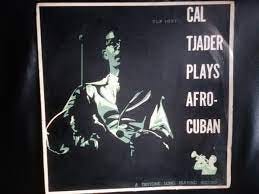The Shade of Tjader in the Seventies
Contemplating a small slice of a large discography
You didn’t have to be a superstar to sustain a steady career as a recording artist in the 1950s and ‘60s. R&B, rock and jazz artists with some measure of name recognition documented original work regularly, growing the audience at a walking pace, door-to-door. Making records in those days was, to some degree, about the long game. (Certainly more than it is today.)
The vibraphonist and bandleader Cal Tjader was one of those artists who cranked out lots of records; in 1958, just a few years after making his debut, five records under his name were released on Fantasy Records. He probably participated in a few more as a sideman that year, and then after he was signed by Verve in 1962, he had another 5-LP year. Five albums in the space of 12 months. Like it was no big deal.
Did that prodigious output make sense back then? Does it now? At the least, the sheer number of titles makes it somewhat challenging to explore Tjader’s discography: Does one start with one of those now-ubiquitous career-overview playlists, or follow the recommendations on a Top Five Essential Albums list, or just default to some greatest hits package?
To grok Tjader you probably need to understand a bit about his approach to recording: As his career developed and his recording budgets increased, he changed his focus from project to project, exploring Afro-Cuban styles on one record, Brazilian samba derivations on the next, soul-jazz-style boogaloo after that. This was more than just rhythmic curiosity; by working diligently to assimilate and then explore various sub-genres, Tjader became a key figure, possibly the key non-Latino figure, in Latin jazz. As happens with many prolific artists, though, the Tjader oeuvre has its ups and downs; while just about every record contains some sparkling mallet solos, there are more than 60 titles, many with titles like Cal Tjader Plays Afro-Cuban and Cal Tjader’s Latin Kick. Let’s just be diplomatic: They’re not all top shelf.
Prompted by a press release about a new version of Huracan, Tjader’s unusual 1978 live-in-the-studio project for an audiophile label, I started checking out the records he made around the same time, from 1976 to 78. This isn’t generally regarded as a peak period of creativity for him – it’s a decade after his breakthrough hit Soul Sauce, and a few years after the fiery Primo, which features a roaring orchestra of New York veterans. Still, during that period, Tjader created improbable, enduring, earthy music that recalibrates traditional Latin and samba rhythms with elements of jazz-rock fusion.
Perhaps because of their proximity to fusion, these titles frequently get overlooked in the “Essential Works” conversations, but they shouldn’t: Amazonas, from 1976, is on my shortlist of albums that transcend genre categories so completely as to define an entire zone of creativity. Its stylistic collisions, which were arranged by keyboardist George Duke, anticipate later landmarks including Duke’s A Brazilian Love Affair; its textures include crazy skronky Stevie Wonder-style synthesizers (from Brazilian multi-instrumentalist and composer Egberto Gismonti!) and gorgeous impressionistic flute from the master Hermeto Pascoal.
Amazonas is one of Tjader’s Brazil records; it stands among his most ambitious and fully-realized projects overall, envisioning fusion as a basis for elastic, sometimes frenetic interactivity. Tjader followed this with a crisp live record (At Grace Cathedral) and the also-underestimated Guarabe. This is a nicely recorded studio date built around the shapeshifting conversational dynamic between Tjader and the electric pianist Clare Fischer and anchored by then rising conguero Poncho Sanchez. The selections include a few gingerly-reimagined pop tunes (Bread’s “If,” Leon Russell’s “This Masquerade”), a minor Brazil classic (Edu Lobo’s “Reza”), and Tjader’s moody original “Black Orchid.”
The next year, Tjader recorded Huracan, a one-off direct-to-disc experiment for the Crystal Clear audiophile label; reissues of this one have been sporadic (and of varying quality), making it one of the titles in Tjader’s catalog that’s been hard to find. This live-in-the-studio date, recorded over two days, features a large-ish ensemble anchored again by Sanchez alongside timbale master Willie Bobo; Fischer returns to provide sassy big-band-style arrangements as well as electric piano. The band was set up in a large room at Wally Heider’s Hollywood studio, and captured with just four overhead microphones. The result is an intimate rendering of a band at work – each musician participates in the surges of intensity and loud/soft dynamics, and it’s possible to hear Tjader adjusting his attack and “touch” on the vibraphone to sculpt and shape the overall sound. It’s an excellent way to appreciate the small grace-note-sized gestures that were a distinct facet of Tjader’s sound.
This focus on a limited time period and only a few releases doesn’t offer a wide-angle view of Tjader’s evolution. Instead, it’s a sliver from a long long career. It shows how this artist continued to innovate within his original lane (Latin jazz) and then, once in a while, managed to level up and rethink everything with a groundbreaking work like Amazonas. Over and over again, Tjader met the challenges of a demanding recording schedule; as his 76-78 output argues, he managed to stretch and keep stretching artistically, sometimes in bold ways and sometimes via small astonishments. It’s just a slice, but it tells a larger story about making music – project after project, year after year.





Wow. I’ll have to dig up AMAZONAS. Love anything with Gismonti or Hermeto. Tjader’s always been hit n miss for me but the stuff I love I adore, so as always Moon, thx for the tip.
You put into words what I have been thinking for many years about Tjader! Mazel tov!